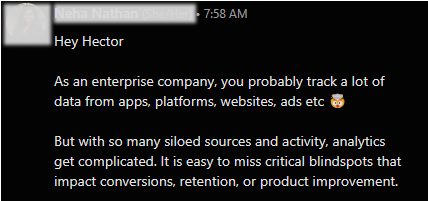Many factors play a role when trying to move the needle of revenue generation. But one that usually gets overlooked is the sales content.
When used strategically, sales content can help you move deals forward in the pipeline or educate prospects that are still not ready to buy.

However, the biggest challenge in having a library of sales content is making your revenue team accountable for it.
By the end of this blog, you’ll have a solid understanding of sales content, who are the teams involved in its creation and an outline of the process to start creating sales.
What is Sales Content
Coby Bray and Hilmon Sorey define content as an asset that should be available for sales reps at the right time to move deals forward. Most importantly, this content is part of a bigger process and ecosystem called sales enablement.
When referring to sales content, it’s important to drop the “sales” part of the concept and really focus on the latter.
This will allow us to stay away from the traditional 50-page sales catalogue or the one-size-fits-all demo and really think of content as a value-creation element that drives customer loyalty and differentiation.
Here’s another fact: Gary V recommends that companies think like media companies because of the power content has in fostering relationships with your target customers and boosting business growth.
So what is sales content anyway?
Content is a piece of value you create with your customers and prospects in mind about why, how and what your company does and stands for.
Sales Content is any piece of information that a sales representative can use to provide guidance in the buying process.
Now that we’ve covered the basics, let’s continue on who is involved in the creation process.
Building a Sales Content Creation Process
When creating a business process, we need to consider some key elements that are critical to its success.
For this particular case, I’ll review the objectives, activities, resources, and metrics of the content creation process.
The objective
As mentioned above, content can help build relationships with your target audience and customers. It also helps differentiate your business from its competitors. When produced correctly, content can help the sales team qualify leads and close prospects more effectively.
So when defining your content creation process, think about what business goal you want to achieve and how the process will connect the dots so the people involved can contribute to and be accountable for.
An example using the OKR model:
Objective: Reduce the sales cycle by incorporating personalized content.
Key Results:
- Develop and deploy personalized content templates for each stage of the sales funnel within two months.
- Train the sales team on using personalized content strategies in their outreach efforts.
- Achieve a 20% reduction in the average time to close deals within the next quarter.
- Increase the open rate of personalized email campaigns by 25%.
The activities and resources
Following our OKR example for the content process, we can see that the activities are related to producing and delivering the content and training the team.
Producing sales content must be a function shared across the revenue team: marketing, sales, and customer service. If you are a SaaS, add the product team to the mix.
What does that mean? Well for starters, everyone who does a client-facing activity has the potential to capture customer insights. This input is very practical when developing content.
Going over the questions available on your customer service team’s shared inbox will produce far more content ideas than trying to brainstorm your next ebook.
The takeaway is that the people who interact with your clients and prospects are more familiar with the everyday questions that come up about your product or service. If your marketing team is not sensitive to this, start doing it now.
The next action is training the sales team. This is more related to providing them with the resources and tools to leverage the right content at the right time to the right person.
The metrics
There’s a popular saying that you can not control what you don’t measure.
So how do you know that your sales content is moving the needle of revenue generation? For that, I like to focus on two types of metrics: the performance metrics of the pipeline and the metrics related to the outcome of the sales process.
It might sound like they are the same, but obviously if the content is working, then the stage conversion rate must be improving. But that is a business metric, the other side of the coin is helping your potential client move to the next milestone on their customer journey.
In their book Forget the Funnel, Claire and Gia explain the steps to adopt a customer-led process that can boost revenue using the insights of your ideal clients.
The proposed paradigm of doing business metrics from the perspective of the customer journey helps tie everything together in the content creation process.
The takeaway is that when you create content based on the insights of your ideal customers, each piece of information has the potential to improve the metrics of your pipeline and help your ideal client make an informed buying decision.
3 Scenarios Where You Can Start Incorporating Sales Content
Sales Content in Qualifying Prospects
Content such as case studies can explain much better how the features of your product or service create value for the pain points they are trying to solve.
This is a great type of resource that your sales team can use during the exploratory meetings.
Being able to identify the pain is an essential skill for sales reps, but so is being able to tell how your company solves that problem.
Nurturing Prospects with Targeted Content
The struggle to make a decision will impact the length and outcome of your sales process. Creating content for each stage of the sales process and type of entry barrier can speed things up.
Using automation tools can ensure you are delivering the right content at the right time.
Warming up Cold Outreach with Sales Content
If you are a LinkedIn user, I’m sure that you’d receive requests to connect and then immediately receive an inbox message telling you that you are a company/role that needs XYX.

The problem is that most of the time, that message feels odd due to a lack of context + personalization.
Sure LinkedIn offers great tools to segment profiles based on demo data entered by the user on its profile. But that does not mean that you don’t need to review your prospect and try to understand what they do.
When creating the content, try to make it personalized and but also contextualized to the recipient’s industry, pain points, and interests.
Conclusion
Starting with content or sales content is quite the challenge. Try to keep things simple and prioritize quality over quantity and production. A simple email with the right information can be much more effective than a heavily produced video testimonial of your best client.
The struggle of your sales team to move the pipeline is real. Make sure to support them by incorporating Marketing and Customer Service in creating content that brings value to your prospects and clients.


